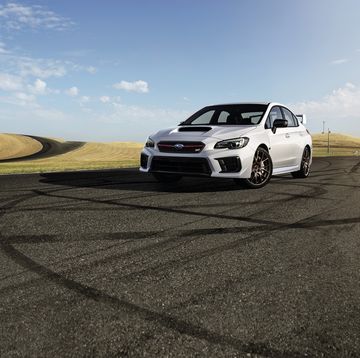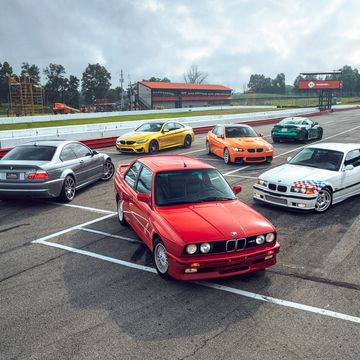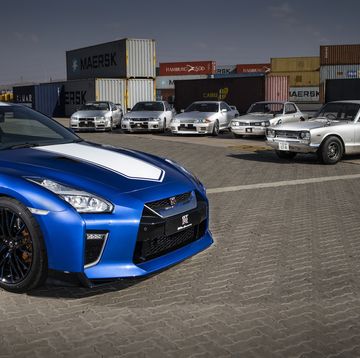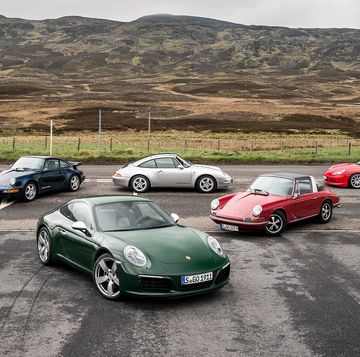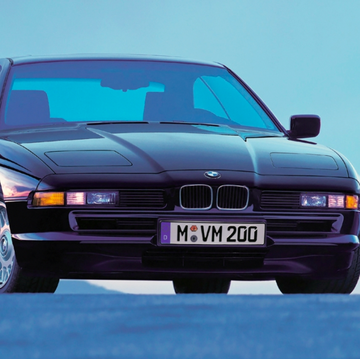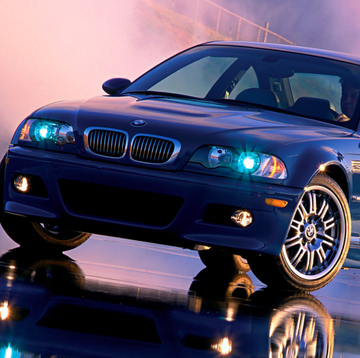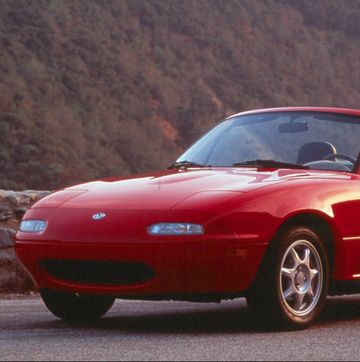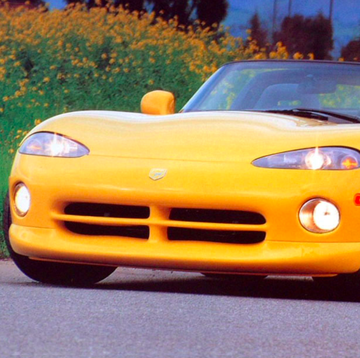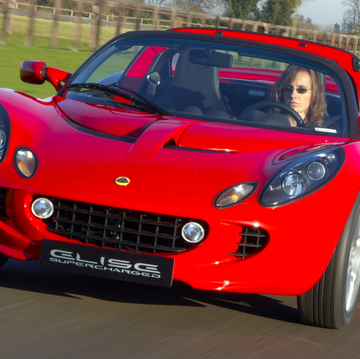The 996-generation Porsche 911 occupies an interesting spot in Porsche’s history. It was the first 911 to use a water-cooled engine, and the first to be built on a modern assembly line, rather than being built by hand. Some people consider it the “worst” 911, and as such, prices have stayed reasonable while other generations skyrocket. Despite its reputation, though, the 996 provides a fantastic driving experience, often at the price you'd pay for a new Miata.
Thinking about buying a 996 of your own? We commend you. Here’s how to find the right one.
A 911 for the 21st Century
First unveiled at the 1997 Frankfurt Auto Show and put on sale for the 1999 model year, the 996-generation 911 was a massive departure from the 35 years of air-cooled 911 magnificence the world was familiar with. Instead of a refreshed version of the 993, this was a completely new, clean-sheet design. Though the silhouette was similar, every aspect of the exterior was modernized, with a streamlined body, an electronically activated rear spoiler, a 0.30 coefficient of drag, and headlights lifted right off the then-new Boxster. Wider, longer, and with a lower roofline than the 993 that preceded it, the 996 was a 21st century 911.
That mindset continued into the all-new interior, completely redesigned with modern audio and HVAC and even optional navigation. The instrument panel kept its signature five-gauge design, but added a trio of digital displays for speedometer, clock and odometer. Thankfully, the ignition switch remained in its traditional left-hand position.
Perhaps the biggest change implemented for the 996, though, was in the engine bay. While the car still used the traditional rear-mounted flat-six, it was no longer air-cooled, a huge departure for Porsche that ruffled the feathers of many air-cooled purists. The motor, designated M96, displaced 3.4 liters in the base Carrera and all-wheel drive Carrera 4, making 296 horsepower and 258 lb-ft of torque. In our initial testing of the car, we were able to clock a 0-60 time of just 4.6 seconds.
The Carrera and Carrera 4 coupe and cabrio models were joined by the hardcore GT2 and the ultra-quick Turbo for the 2001 model year. All 996s got a major refresh in 2002, along with a bigger engine and the new Targa and Carrera 4S models. The base engine, now displacing 3.6 liters, was rated at 320 horsepower and 273 lb-ft of torque.
The Turbo received a host of upgrades over the standard car, the most significant of which was a twin-turbo 3.6-liter flat-six making a substantial 415 horsepower and 415 lb-ft of torque and sending power to all four wheels. Visually, the Turbo stands apart with wider fenders, a fixed rear spoiler with a secondary piece that automatically raises at 75 mph, a third radiator up front, and air inlets behind the doors. With the optional X50 package, power rose to 444 thanks to bigger turbos. Before the GT2's introduction, the 996 Turbo was the fastest road-legal 911 of all time, with a top speed of 189 mph. Thanks to its low-end torque and AWD traction, it could sprint to 60 mph in just 3.7 seconds.
Many publications called the Carrera 4S the sweet spot in the 911 lineup when it was introduced, providing more performance than the base car without the exorbitant pricing of a Turbo or GT2. The Carrera 4S paired the aggressive bodywork and suspension of the Turbo with the base Carrera 4 drivetrain, though it didn't get the Turbo's huge rear wing. It’s easily identified by “Carrera 4S” badging and a large reflective strip on the rear end, spanning the gap between the taillights.
The 996-generation Targa is based on the Carrera Cabriolet, but like the 993 Targa before it, uses a fixed roof with a sliding glass top to provide an open-air experience. This trend would continue into the 997-generation 911, before Porsche eventually introduced an entirely new power-folding canvas roof design for the 991 Targa.
On the extreme end of the 996 spectrum sits the GT2. It’s essentially a hardcore Turbo model with track intentions—rear-drive only, with no rear seats and no stability control. The twin-turbo engine made 462 horsepower and 457 lb-ft of torque thanks to more boost, more efficient intercoolers and an optimized exhaust system. The GT2's unique aero package with a bespoke front air dam and spoiler, made 120 pounds of downforce at 190 mph, with a top speed of 196.
Though the GT3 had been on sale in Europe for years, it wasn’t until the 2004 model year that Porsche brought the specialty model to America. Arguably the most desirable 996 trim to be sold in the U.S., it's powered by a 375-horsepower naturally aspirated 3.6-liter engine with upgraded internals, paired to a six-speed manual transmission sending power to the rear wheels. A stout suspension setup, phenomenal brakes, and a wonderful exhaust note made it a gold standard for street-legal track cars of the era.
Towards the end of 996 production, Porsche added a Turbo S trim to the lineup. Essentially a Turbo with some previously-optional equipment as standard, it included the horsepower-boosting X50 package, along with carbon-ceramic brakes and six-piston calipers.
So Which One Is Best for Me?
The best 996 for you depends largely on how you plan to use it and how much you want to spend. Prices can range from $10,000 for a high-mileage base Carrera Cabrio in ratty shape to $120,000 for a GT3 in excellent low-mile condition.
If, like most prospective 996 buyers, you’re looking for a cheap way into 911 ownership, consider an early Carrera or Carrera 4. Depending on mileage, used examples in good running condition can be found in the $15,000-to-$35,000 range. No, it’s not going to be as quick or capable as something like a Turbo or GT3, but remember: You’re still getting a 911, complete with a great-sounding flat-six engine and the handling dynamics you’d expect from Porsche’s flagship. Cabriolets tend to be priced a bit lower than coupes, and automatics are cheaper than manuals.
Looking for more performance, but don’t want to drop cash on a Turbo, GT2, or GT3? The Carrera 4S might be the 996 for you. It splits the difference, using the 320-horsepower Carrera drivetrain and the body and chassis of the Turbo. No, there’s no big wing out back, but we guarantee you’ll still be having a good time. The 4S adds around $5000 to $10,000 to the price of a base Carrera in comparable condition. Weirdly, Porsche never made a rear-drive version of this package, so if you’re not into all-wheel-drive, you’ll have to look elsewhere in the lineup.
Considering a 996 for track duty? It’s the GT2 or GT3 that you want. Both cars are set up to be pushed to the limit from the factory, with big brakes, sticky tires, and working aerodynamics. Despite the power deficit, we’d say the GT3 is the more desirable of the two, as it’s a more balanced package with a more memorable engine. Unsurprisingly, the GT-badged 996s are the most expensive on the secondhand market, with prices ranging from $75,000 to $130,000 depending on mileage, modifications, and how much time they’ve spent on track.
If you’re the collector type, you can’t go wrong with either GT car. But despite their price similarities, it’s worth noting Porsche built around four GT3s for every GT2. So if rarity is your thing, we’d say go for the GT2. There are also two special-edition 996s: a Millennium Edition based on the 2000 Carrera 4, of which only 911 examples were built, and a 40th Anniversary Edition based on the 2003 Carrera, of which 1963 were built. Though the Millennium car is rarer, the 40th Anniversary 911 is the more appealing one (to us, anyway), since it received 25 more horsepower over stock, a sportier suspension setup, and a limited-slip differential as standard.
The Turbo model hasn’t retained value like its GT-badged siblings, and as such, it represents a fantastic value proposition. It’s not hard to find high-mileage examples listed for under $40,000, which gets you a ton of car for the money. A 415-horsepower AWD Porsche 911 for less than the price of a new four-cylinder Supra? Sign us up. The best part? The 996 Turbo’s engine doesn’t have the weak points common to naturally aspirated cars of this generation, meaning a lower likelihood of catastrophic engine failure. (More on that in a minute.)
So What Sort of Issues Do I Have to Look Out For?
Porsche has a reputation for reliability, but some people consider the 996 an exception. What do we think? Well, it’s a German car that’s now over 20 years old—any example is going to require a bit more maintenance than a brand-new car. You just have to know what to look out for before you buy.
The 911 shares much of its engine architecture with the 986-generation Boxster, and both share similar weak points. The most widely-known issue involves the base engine’s intermediate shaft (or IMS) bearing, which, in some cases, can fail without warning, contaminating the oil with metal and potentially leading to complete engine failure. Though fear of IMS failure may be a bit overstated in some corners of Porsche enthusiast internet, the issue is common enough that several companies offer stronger aftermarket IMS bearings to be installed preventatively. If you’re checking out a Carrera, Carrera 4, or Carrera 4S, it’s worth finding out whether the IMS bearing has been replaced—considering how expensive the parts and labor are, the car’s value can swing one way or the other depending on the answer. Since the Turbo, GT2, and GT3 use a different engine architecture, they aren't subject to the same IMS bearing issues.
In rare cases, early M96-engine cars can suffer from cracked cylinder liners and cylinder scoring. Since these cars have been on the road for around two decades, however, it’s likely that most affected engines have been repaired or replaced (it’s still something to keep in mind, though). Pcarwise.com has a great guide that can help you determine the health of a 996 engine without having to crack it open.
Oil seepage is normal on these cars as mileage increases, so don’t be surprised to look under the car and see wet spots originating from places like the rear main seal. As long as there aren’t puddles forming under the car, it’s not too big of an issue—just remember to keep an eye on the oil level. Similarly, rubber pieces in the cooling and suspension system will likely be showing their age, so make sure to check those items as well before you buy. We recommend taking out the guesswork and paying for a pre-purchase inspection—ideally done by a Porsche specialist—so you don’t miss anything.
What about the Community?
Considering Porsche is one of the most popular performance brands in the world, you shouldn’t have any trouble finding a club, group, or calendar of events near you where you can get involved. There are large forums online with all the information you could ever need regarding buying, maintaining, or selling your Porsche, with plenty of people willing to assist with whatever questions you may have.
If you want to get the full experience, we recommend joining the Porsche Club of America and checking out what sorts of upcoming events they have in store. It’s also worth keeping an eye out for high-end events like Luftgekühlt if you’re the obsessive type.
Check out the rest of our buyer's guides right here!

Brian Silvestro is Hearst Autos' former lead deputy editor for rankings content. He spent over seven years as a staff writer for Road & Track Magazine where he contributed car reviews, industry interviews, and more. He has a taste for high-mileage, rusted-out projects and amateur endurance racing.









